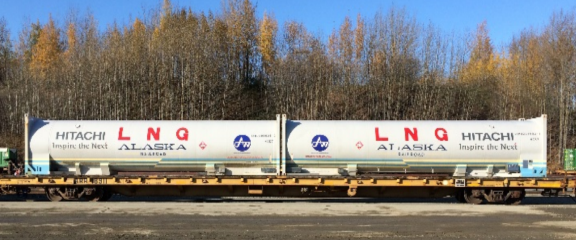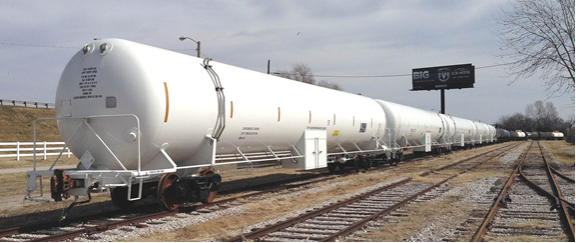
Source: Federal Railroad Administration, Office of Technical Oversight, slide presentation.
On October 24, 2019, the Pipeline and Hazardous Materials Safety Administration (PHMSA), in coordination with the Federal Railroad Administration (FRA), published a proposed rule to authorize the transportation of liquefied natural gas (LNG) in rail tank cars. This publication was the latest federal action intended to provide "greater flexibility in the modes of transportation" of LNG to serve domestic and export markets. The proposed rule could conflict with legislation approved by the House of Representatives earlier this year.
Natural gas cooled below -260° F at normal atmospheric conditions condenses into a liquid with 1/600th of its gaseous volume. In this form, it can be economically transported in insulated tanks. When LNG is warmed it "regasifies" and is used the same way as natural gas supplied by pipeline. Like other gaseous or vaporized fuels, natural gas is combustible, so an uncontrolled release of LNG poses a risk of fire or, in confined spaces, explosion. Due to its low temperature, LNG also could injure people or damage facilities through direct contact. Partly because of these safety risks, LNG shipment and the development of related facilities have been controversial in some communities.
Domestic transportation of natural gas occurs mainly by pipeline. However, not all parts of the United States have sufficient pipeline capacity to meet expected growth in demand. Furthermore, proposed pipelines in New England, New York, and the Mid-Atlantic have encountered legal and regulatory challenges. These challenges have prompted proposals to ship LNG by rail to markets with constrained pipeline capacity. The Federal Energy Regulatory Commission has determined that such "virtual pipelines" are not an economically practical alternative to a major pipeline project "based on the number of ... rail cars that would be needed to transport the project volumes and the facilities, time, and cost necessary to process and deliver these volumes." Nonetheless, some in the energy sector believe LNG by rail may be economic in specific markets or at specific times, such as peak heating season in the Northeast. Consequently, certain natural gas market participants and trade groups assert LNG shipment by rail presents "a growing opportunity."
LNG has been shipped between U.S. and overseas ports in large marine vessels for over 60 years. LNG also has been transported domestically by road in specialized tanker trucks since the 1970s. However, domestic shipment of LNG by rail is relatively new. Federal Hazardous Materials Regulations prohibit rail shipment of LNG except by PHMSA special permit or with FRA approval. The FRA granted the first such approval in 2015 to the Alaska Railroad Corporation, which has subsequently transported LNG by rail in multi-modal tank containers (Figure 1) from Anchorage to Fairbanks. The FRA issued a second approval in 2017 to the Florida East Coast Railroad, which is using LNG as a locomotive fuel and is testing LNG transport in tank containers from Jacksonville to Miami for export to the Caribbean.
 |
|
Source: Federal Railroad Administration, Office of Technical Oversight, slide presentation. |
PHMSA's proposed rule could expand rail shipment of LNG well beyond what the FRA has allowed. The agency's rule aligns with an April 10, 2019, executive order directing the Secretary of Transportation to propose a rule that would "permit LNG to be transported in approved rail tank cars" to be issued by May 2020. It also responds to a 2017 petition from the Association of American Railroads (a trade group) and a 2019 special permit application from Energy Transport Solutions, a prospective LNG shipper.
PHMSA's draft environmental assessment for the special permit states that the applicant intends to ship LNG in "unit trains," which carry one commodity in as many as 100 rail cars. Unit trains are already used in the United States for the shipment by tank car of other energy commodities such as propane and crude oil. However, the FRA has stated that "the transportation of large quantities of LNG in a single train presents unique safety risks." For similar reasons, a 2014 study for the Maritime Administration examining LNG as a maritime fuel recommended that prospective shippers of LNG by rail (to ports) "perform a detailed study of potential routes for LNG transportation ... that avoid densely populated areas and identify emergency response capabilities." PHMSA's rulemaking is examining potential limitations for routes and train length specifically for LNG shipments in rail tank cars. Speed restrictions and advanced braking devices are also under consideration.
PHMSA's proposed rule would allow LNG to be carried in DOT-113C120W specification tank cars (Figure 2), which are designed to carry liquefied ethylene, "another flammable cryogenic liquid which shares similar chemical and operating characteristics with LNG." The proposed rule does not discuss specific tank car features designed to reduce the chances of tank car punctures during derailment, such as those newly required of cars carrying crude oil. The proposed rule also does not specifically indicate whether LNG would be restricted to routes equipped with positive train control, an advanced signaling system designed to avert collisions due to conflicting train movements, although it does reference an industry standard that implies this requirement.
 |
|
Source: Courtesy of Chart Industries. |
On June 24, 2019, the House approved an appropriations bill amendment (H.Amdt. 468 to H.R. 3055) to prohibit the Secretary of Transportation from using appropriated funds to carry out the LNG by rail provisions of the April 10 executive order. It also would prohibit the Secretary from using appropriated funds to authorize LNG transportation in rail tank cars by issuance of a special permit or approval. On September 12, 2019, the Chairman of the House Committee on Transportation and Infrastructure introduced the Protecting Communities from Liquefied Natural Gas Trains Act (H.R. 4306), which would require the FRA and PHMSA "to conduct an evaluation of the safety, security, and environmental risks of transporting liquefied natural gas by rail." To what extent large rail shipments of LNG materialize, and where, will be determined by market factors as well as regulation.